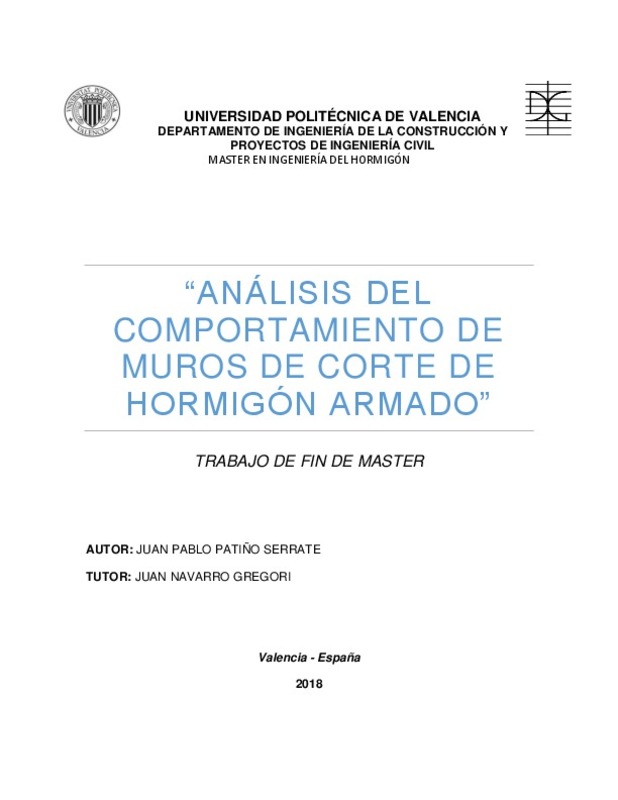JavaScript is disabled for your browser. Some features of this site may not work without it.
Buscar en RiuNet
Listar
Mi cuenta
Estadísticas
Ayuda RiuNet
Admin. UPV
Análisis del comportamiento de muros de corte de hormigón armado
Mostrar el registro sencillo del ítem
Ficheros en el ítem
| dc.contributor.advisor | Navarro Gregori, Juan
|
es_ES |
| dc.contributor.author | Patiño Serrate, Juan Pablo
|
es_ES |
| dc.date.accessioned | 2018-02-07T13:45:23Z | |
| dc.date.available | 2018-02-07T13:45:23Z | |
| dc.date.created | 2018-01-19 | |
| dc.date.issued | 2018-02-07 | es_ES |
| dc.identifier.uri | http://hdl.handle.net/10251/97425 | |
| dc.description.abstract | Una gran cantidad de edificios se construyen utilizando muros de corte de hormigón armado, para brindar mayor rigidez y resistencia a esfuerzos horizontales producidos por las acciones del sismo y del viento. La gran mayoría de los ingenieros calculistas diseñan estos muros de corte tomando en cuenta exclusivamente la rama elástica-lineal de los materiales, obteniendo así elementos de hormigón que cumplen los requisitos normativos, pero que quizás se encuentran sobredimensionados. En este trabajo de fin de máster, se comparan las ventajas que se tiene entre realizar un análisis de muros de corte tomando en cuenta solamente su comportamiento elástico-lineal, y de realizar el diseño de los muros de corte analizando con más profundidad su comportamiento, tomando en cuenta la no linealidad que presentan los materiales. Para realizar esta comparación se consideran varios puntos que se explican a continuación. Como primer punto se realiza el diseño estructural de edificios tipo bolivianos de hormigón armado, de distintas alturas, tomando en cuenta el comportamiento elástico-lineal de los materiales. Se prosigue con la realización de un análisis individual de muros de corte, tomando como datos de partida los esfuerzos y armaduras de refuerzo obtenidos en el diseño inicial. En este análisis se toma en cuenta características de no linealidad de los materiales, de manera, de obtener datos que se asemejan de mayor manera al comportamiento real de los muros de corte. Para concluir, se realiza una comparación entre los datos obtenidos en el primer diseño y los resultados obtenidos del análisis posterior, pudiendo así, observar las ventajas y desventajas que se tiene al realizar un análisis más detallado de elementos de hormigón armado. Los resultados obtenidos serán de valiosa importancia, debido a que si se demuestra que los elementos de muros de corte están sobredimensionados, se fomentará a que los ingenieros estructurales realicen un análisis con más detenimiento de estos elementos, para así poder realizar un diseño más eficiente y económico. | es_ES |
| dc.description.abstract | A large number of buildings are built using reinforced concrete shear walls, to provide greater rigidity and resistance to horizontal stresses caused by earthquakes. The great majority of engineers design these shear walls taking into account exclusively the elastic-linear branch of the materials, thus obtaining concrete elements that follows the regulatory requirements, but which may be over-dimensioned. In this master's thesis, we compare the advantages of the analysis of the shear wall taking into account only its elastic-linear behavior, and designing the shear walls, analyzing its behavior, taking into account the non-linearity of the materials. To make this comparison, several points are considered, which are explained below. The first point is the structural design of traditions Bolivain reinforced concrete buildings of different heights, taking into account the elastic-linear behavior of the materials. We proceed with the realization of an individual analysis of shear walls, taking as starting data the tensions and f reinforcement bars obtained in the initial design. In this analysis, characteristics of non-linearity of the materials are taken into account, in order to obtain data that resemble the actual behavior of the shear walls more closely. To conclude, a comparison is made between the data obtained in the first design and the results obtained from the subsequent analysis, thus being able to observe the advantages and disadvantages of a more detailed analysis of reinforced concrete elements. The results obtained will be of great importance, because if it is demonstrated that the elements of shear walls are oversized, it will encourage structural engineers to perform a more extended analysis of these elements, in order to make a more efficient and economic design. | es_ES |
| dc.language | Español | es_ES |
| dc.publisher | Universitat Politècnica de València | es_ES |
| dc.rights | Reserva de todos los derechos | es_ES |
| dc.subject | Shear | es_ES |
| dc.subject | Concrete | es_ES |
| dc.subject | Earthquake | es_ES |
| dc.subject | Wall | es_ES |
| dc.subject | Muros | es_ES |
| dc.subject | Pushover | es_ES |
| dc.subject | Sismo | es_ES |
| dc.subject | Hormigón | es_ES |
| dc.subject | Cortante | es_ES |
| dc.subject.classification | INGENIERIA DE LA CONSTRUCCION | es_ES |
| dc.subject.other | Máster Universitario en Ingeniería del Hormigón-Màster Universitari en Enginyeria del Formigó | es_ES |
| dc.title | Análisis del comportamiento de muros de corte de hormigón armado | es_ES |
| dc.type | Tesis de máster | es_ES |
| dc.rights.accessRights | Abierto | es_ES |
| dc.contributor.affiliation | Universitat Politècnica de València. Departamento de Ingeniería de la Construcción y de Proyectos de Ingeniería Civil - Departament d'Enginyeria de la Construcció i de Projectes d'Enginyeria Civil | es_ES |
| dc.description.bibliographicCitation | Patiño Serrate, JP. (2018). Análisis del comportamiento de muros de corte de hormigón armado. http://hdl.handle.net/10251/97425 | es_ES |
| dc.description.accrualMethod | TFGM | es_ES |
| dc.relation.pasarela | TFGM\80670 | es_ES |






